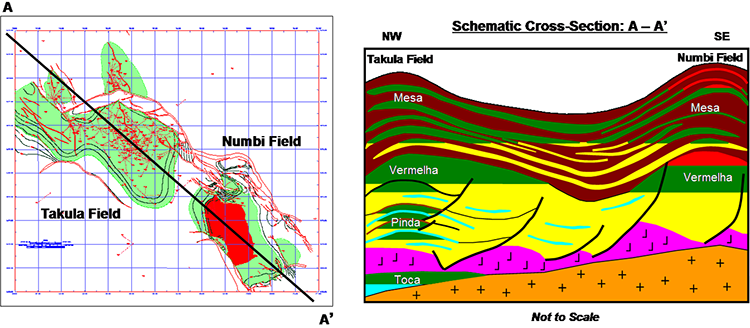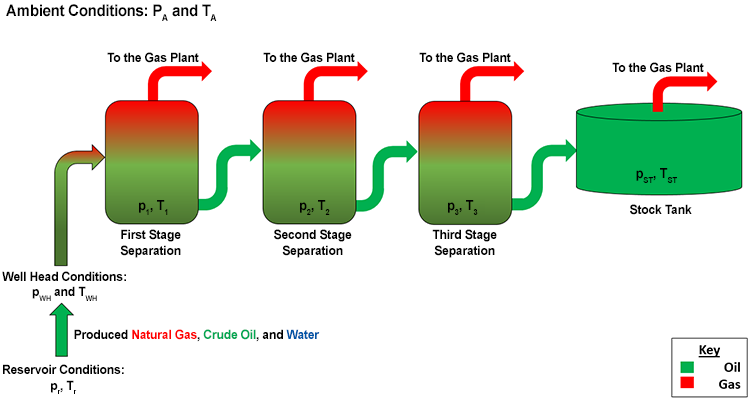The domestic United States oil and natural gas industry uses a very specific set of measures and units that were common at the dawn of the industry and, at least in the U.S., have been retained and expanded upon over the years. These units are often called Oilfield Units. In the international oil and gas industry, the metric system or the related S.I. (Systeme Internationale) system are used. In this course, we will use the U.S. domestic, oilfield units.
The standard measure of volume in the U.S. oil and gas industry is the Barrel (bbl) for liquids and the cubic foot (ft3) for gases. The barrel is defined as 42 U.S. gallons. That is:
You have probably noticed that the unit for barrel, “bbl,” has two “b’s”, while the word for barrel only has one. One story relating the origin of the unit “bbl” and the measure of 42 U.S. gallons follows[2]:
In the early 1860s, when oil production began, there was no standard container for oil, so oil and petroleum products were stored and transported in barrels of all different shapes and sizes (beer barrels, fish barrels, molasses barrels, turpentine barrels, etc.). By the early 1870s, the 42-gallon barrel had been adopted as the standard for oil trade. This was 2 gallons per barrel more than the 40-gallon standard used by many other industries at the time. The extra 2 gallons was to allow for evaporation and leaking during transport [sic] (most barrels were made of wood). Standard Oil began manufacturing 42 gallon barrels that were blue to be used for transporting petroleum. The use of a blue barrel, abbreviated "bbl," guaranteed a buyer that this was a 42-gallon barrel.
In August of 1866, independent American oil producers met in Titusville, PA and agreed that the 42 gallon barrel would be the industry standard in the U.S.A. [3]
Because of the slightly compressible nature of liquids and the compressible nature of gases, the volume of a given mass of liquid or gas at one set of pressure and temperature conditions will not equal the same volume at a different set of pressure and temperature conditions. To provide a common measure of volume, we can specify the volume of a given mass measured at a reference pressure and temperature.

For liquids, the Upstream Oil Industry uses the pressure and temperature at Stock Tank Conditions as the reference conditions for discussing standardized volumes. The stock tank is the last vessel used in the field separation of crude oil and natural gas prior to the transport to other field processing plants (local oil or gas plants) or export to a distant refinery. The Stock Tank Pressure and Stock Tank Temperature make up a field dependent set of conditions which are determined by the pressure and temperature that maximizes the volume of the produced oil. In other words, a crude oil with a specific composition is produced from a reservoir and the field Separator and Stock Tank conditions are adjusted to maximize the volumetric yield of the crude oil. The pressure and temperature conditions that maximize the crude oil volume from one reservoir will be different from the pressure and temperature conditions that maximize the crude oil volume from another reservoir due to the difference in the crude oil compositions. Thus, the stock tank pressure and stock tank temperature in one oilfield may be different from the stock tank pressure and stock tank temperature in another oilfield. Representative stock tank conditions may be on the order of 100 psi and 75°F. Figure 3.02 shows a typical, three-stage, gas-oil Separation Train.

In this figure, the stock tank pressure and temperature, pST and TST, are the field-specific reference pressure and temperature used in all reservoir engineering calculations for crude oil and produced water. When referring to liquid volumes at stock tank conditions, we use the units of Stock Tank Barrels (STB).
For gases, we use Standard Conditions, pSC and TSC, as the reference conditions for volumetric reservoir engineering calculations. Standard conditions are defined by different governments, scientific agencies, industries, or in some instances, specific legal contracts. The Society of Petroleum Engineers (SPE) defines these conditions as pSC = 14.696 psi (101.325 kPa) and 59°F (15°C). Informally, many engineers use pSC = 14.7 psi and 60°F. The appropriate set of standard conditions to be used in engineering calculations will often be dictated by the company and the location where the engineer works. When referring to the gas volumes at standard conditions, we use the units of Standard Cubic Foot (SCF).
For volumetric rate calculations, the U.S. oil and gas industry uses the symbol “q” for the volume of oil or gas produced (or transported) over a 24-hour period. Thus, we have:
- qo = STB/day for oil (at stock tank conditions)
- qw = STB/day for water (at stock tank conditions)
- qg = SCF/day for gas (at standard conditions)
When we consider volumes at a field scale, we often need to use units greater than the stock tank barrel, STB, or the standard cubic foot, SCF. For this, the oil industry uses the uppercase letter “M.” This stands for thousands of STB or SCF. For example, the unit of MSTB refers to thousands of STBs, and the unit of MSCF refers to thousands of SCF. Likewise, the unit of MMSTB refers to millions of STBs, and the unit of MMSCF refers to millions of SCF.
| 1 MMSTB | = 1,000 MSTB | = 1,000,000 STB |
| 1 MMbbl | = 1,000 Mbbl | = 1,000,000 bbl |
| 1 MMSCF | = 1,000 MSCF | = 1,000,000 SCF |
| 1 MM ft3 | = 1,000 M ft3 | = 1,000,000 ft3 |
| 1 MMSTB/day | = 1,000 MSTB/day | = 1,000,000 STB/day |
| 1 MMSCF/day | = 1,000 MSCF/day | = 1,000,000 SCF/day |
[2] Source: Seeking Alphaα - Where Does That 2nd 'B' in the Abbreviation for Crude Barrels (BBL) Come From?
[3]Source: American Oil & Gas Historical Society - History of the 42-Gallon Oil Barrel